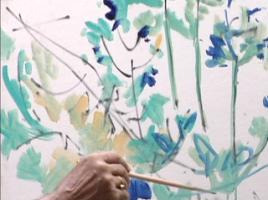Red. Stone. Darkness. These features had captivated my imagination when I first visited the Kamakhya Temple in Spring, 2009. From my very early moments here I had felt exposed to a distinct aesthetic. Absorbing the temple's spectacular structure, its iconic dome and the numerous sculptures that adorn its outer facade and inner walls - I had felt I was witness to a poetry of human hands impressed, timelessly, upon stone. Kamakhya's aural atmosphere: the guttural echoes from the temple's central shrine, terrorising cries of sacrifice, whispered prayers, ancient chants and temple bells all mix randomly, with particular sensations - the coolness of waters from a natural spring in the shrine; layers and layers of vermillion smearing on the temple's sculptures testifying how antiquity persists into the present; the rugged textures of stone from which the temple has been carved and on that stone islands of polished smoothness from the touch of millions of hands raised in worship over centuries. I was certain that it would be grossly limiting to declare Kamakhya a visual spectacle only. In fact it is far from that.
The temple's central shrine is a cave that houses a rock. This rock bears a triangular impression considered to be an abstraction of Mother Goddess Kamakhya's organ. This cave is dark, partially illuminated by the glow of oil lamps that are offered to the Goddess and that orient throngs of devotees who visit Her daily. The triangular rock is covered in red cloth and on any instance it remains buried under layers of red flowers, usually hibiscus, a particular offering to this Goddess. The Goddess's organ is Sacred. And Secret. It is not an object on display and a devotee's encounter with the Goddess does not take place by looking at her. Instead the meeting of the devotee with the divine takes place through touch. The priests serving the Goddess assist each devotee to prostrate before Her and they often hold your hand, guiding it to touch the rock and feel the waters of a natural spring that keep it moistened. This is the Mother, the womb, the source. The austerity of this shrine and its subversion of looking as the principle source of encountering the divine distinguish this temple from most Hindu temples. As a filmmaker I was stimulated by this. The question I carried with me throughout the making of Kamakha: Through Prayerful Eyes was: how would one represent She who is concealed, and remains Herself a secret? No filming, photography or recording of any kind is allowed inside Goddess Kamakhya's cave as a mark of respect towards the sanctity of Her organ. As challenged as I was by this rule, I was also deeply inspired. For film history, all over the world, is replete with instances of objectifying the female form; reducing and ossifying woman as 'visual pleasure' with no currency other than display as her primary function on screen.
Visiting the Kamakhya shrine is considered a journey into the womb. And quite like birth when one leaves the waters of the womb and enters air and light; so also when one steps out from Goddess Kamakhya's enveloping cave one re-enters light. If the concealed rock and spring inside the dark cave are abstractions of the Goddess, then re-entering light and the world is akin to entering the realm of form and representation. No apparatus could parallel this subtle elemental transition more than the camera whose very mechanics operate with and upon light. Cinematography is afterall often termed the art of painting with light. And cameras certainly abound outside Goddess Kamakhya's shrine heightening the play between devotees and the divine. Herein lay my cue - the Goddess resides in Secret, She exceeds representation. Yet stepping out of Her cave one enters a teeming plenitude, a multiverse of visual and aural representations surrounding Her and reflecting how devotees register and memorialise their Goddess. I became interested to plot, through a documentary, the ways in which Goddess Kamakhya is imagined and visualised by her devotees.
The most common representations are visitors' own photographs and videos composed using a whole plethora of cameras ranging from the analog onto digital including mobile phones. There is also an army of professional photographers scouting the temple's many exits. They guide visitors to a selection of platforms from where they can be framed before striking backgrounds. The devotees' photographs are personal, they can be understood as what French critic John Berger designates as the 'private photograph' - one that assumes meaning in a private setting, exercising personal memory. In contrast to this are the proliferating images, icons and prayer objects in the lively bazaar that spills out of the temple complex. The bazaar comprises a whole visual economy composed of narrativised pictographs, posters, calendar art, tantric yantras, statues of Gods linked to Kamakhya, media including DVDs and CDs - all of which depict a Hinduised narrative pertaining to the immolation of Sati on learning the false news of her husband, Shiva's death. It is believed that when Shiva was carrying Sati's body back to heaven, 51 parts of that body fell on 51 sites across India. At Kamakhya, Sati's yoni (womb) is understood as having fallen. Bazaar arts visualise this popular narrative through graphic superimpositions of an embodied Shiva carrying Sati's body back to heaven onto photographic representations of the iconic temple dome. This narrative, local historians hold, was imposed on this shrine in the late 19th-early 20th centuries to bring this region within the Hindu pantheon and through that the burgeoning Indian national project.
Prior to its Hinduisation, Kamakhya was a site of fertility worship for the northeast's matriarchal tribes: the Khasis and Garos. So besides documenting the dominant Hindu narrative popularised by the bazaar art, I wanted to explore whether there were any competing representations or interpretations of this site. It is clearly visible to the naked eye that the temple has been built successively and as such there is no one stable narrative inscribed upon its own body. Alongside figures such as Ganesha sit pre-Aryan, secular sculptures on the temple's outer facade and boundary walls. They depict vignettes of everyday life - a lady pouring water, another kneeling with a bow, a third with her legs spread apart, and yet another, a fine rendition of a mother breast-feeding a baby in her arms. All in delicate and firm poise, marked by an unrestrained, primal eros. Thinking about what these sculptures visualise in relation to Kamakhya I concurred with Assam's eminent poet and art critic, Nilmani Phukan who holds that these are visual glimpses into a society predating settled and mass agriculture in the region, where fertility was closely tied with cosmological and seasonal movements.
Besides documenting these sculptures, which one finds randomly strewn across the temple complex, I wanted to further pursue contemporary visualisations of this site that contest with and override the dominant Hindu narrative. I started by encountering the painter, Kandarp Sarma who was born and lives on Nilachal Hill; his home just a few hundred feet above the Kamakhya Temple. He attended the Vishva Bharati University at Santiniketan and was trained by Indian modern masters such as Nandlal Bose and Ramkinkar Baij. As he unrolled canvases from the Kamakhya Series composed in the 1990s, my camera became witness to a figure who is the repository of 20th century modern art, his own paintings contemporising Kamakhya's antiquarian aesthetics. Cezzane, Gauguin, Picasso, Matisse and Mondrian - these are figures Sarma has closely studied and then developed a form he terms 'non-objective painting.' Here a key influence has been Goddess Kamakhya Herself who Sarma notes as being a formless presence. She, in his view, is the provocateur for the act of making art that can thus be understood as a form of devotion.
Red is his favourite colour. Goddess Kamakhya is identified with red. When he sees animal sacrifice at Kamakhya he says he only sees red colour. His reference to animal sacrifice provided me a valuable opportunity to offer a contrasting interpretation that contests with the widely dismissive view across mainland India about animal sacrifice at Kamakhya. On account of this practice Kamakhya is often termed as a gruesome, tribal site with tribalism understood through a colonially-inflected line of thought as being uncivilised. Kandarp Sarma's evocation of animal sacrifice through painting positions the viewer to approach this practice on creative terms, suppressing any moralising terms.
Kandarp Sarma had observed me framing close-ups of the 'Kamakhya Series' canvases through my camera's viewfinder. Instantly, he had commented that framing a shot was parallel to painting. He started to share suggestions for how he wanted his canvases to appear within the filmed image. This opened a new plane for us upon which to interact. As I elicited his inputs on image composition, I shared with him my urge to document his working methods and I wanted to do this, as far as possible, without relying totally on obvious verbal avenues like interviews or a voice-over narration. This ties to my broader commitments as a filmmaker to explore strategies that facilitate my subjects to express themselves before camera, beyond the established conventions of mainstream documentary films. Cinema is a multi-sensory and temporal medium and I want to explore and exploit its particular potentials. This means moving beyond using it as a tool of communication. I want the viewer to engage and experience multiple perspectives without feeding him/her a determined message delivered by the documentarist as the authoritative figure of information and meaning. Further, as a cinematographer I feel it a duty to research and create a filmic vocabulary that exposits, with integrity, the uniqueness of a film's each character without subjecting them to established conventions of commercial film such as facial close-ups or verbal dialogue and interviews as the only platforms through which they can be presented to the viewer.
Kandarp Sarma painted a fresh canvas for the camera. This was a landscape composition at the Nilachal Hill. He distilled colour, line and movement in the landscape. In filming this process I found myself drawn closer to the canvas both visually and aurally - resulting in textured close-ups with magnified sounds of painting that were composed, not by zooming in from a distance as a voyeur, but by physically placing the camera and mic near the canvas with the artist fully aware and complicit with the camera's presence. Through repeated study of the painting process, I became alert to a rhythm in the movements of Sarma's hands. I selected three segments containing whole movements to execute particular lines and compositions. This process of painting became the source of a narrative structure around which other materials were used to construct on screen Kandarp Sarma as a practising artist of Kamakhya. Here again my aim had been to find a structuring principle related to the character as opposed to imposing criteria external to his world.
I documented a second artist, Suban Das who is a carpenter at Nilachal Hill. He uses leftover wood from his work to make replicas of the Kamakhya shrine that are then sold in the temple bazaar. He is self-taught. Das's models offered me a conceptualisation of Kamakhya that subtly contrasted with Sarma's canvases. His models are part of a whole panorama of commercially driven activities including carpentry and livestock rearing. Das shares in his interview his strategies to secure a market for his models. This is in sharp contrast to Sarma who has not sold any of his paintings ever. He has only gifted them and accepted any payments when they were offered voluntarily. This contrast between the two artists was crucial - it reflected, at a very fundamental level, two competing modalities for visualising Kamakhya - one artist is seeking a market, the other vehemently rejects the circulation of art through market channels. While both artists revealed conceptions of Kamakhya that exceed the dominant Hindu narrative linked to the temple; together they reflect the field of alternative viewpoints as inherently composed of multiple and competing imaginations. There was an obvious risk in reflecting the disparities, particularly the economic motivations of these two artists - the risk being an inadvertent hierarchisation of one figure over the other: Sarma as artist over Das as craftsman, as it were. To contain this it became imperative to situate Das's making of Kamakhya models within the broader array of activities from his everyday life. So we follow him rearing livestock, calling and feeding pigeons and playing his flute - among which sits the sculpting of his models. I have been criticised for this treatment both when I showed a rough cut to a select audience in Assam in summer 2011 as well as on the film's premiere screening in summer 2012. My approach has been deemed as lacking focus, being too descriptive of Das's working processes and even conflicting with the remainder of my documentary that progresses in through poetic juxtapositions. In my view however, situating Das's Kamakhya models within the continuum of his everyday life that is a contained world where the boundary between artistic and economic pursuit is collapsed was key to creating a rounded portrait of him as a character in the film. There is no sanctioned or exalted way through which to experience the Divine, here Mother Goddess Kamakhya. Making the documentary Kamakha: Through Prayerful Eyes presented me, as I hope it does my viewers, the possibility to witness disparate ways through which devotees evoke Goddess Kamakhya, in the process exercising and expressing their own ideological and aesthetic persuasions. This is upheld by Kamakhya's own lack of apparent form or image that inaugurates a possibility of multiplicity in imagining Her.
Note: I started composing this essay on the banks of the Brahmaputra overlooking Nilachal Hill. It was completed at my apartment in LA. My film is titled 'Kamakha...', a spelling of Kamakha that pays homage to the Khasi roots of this temple site.
Find us on facebook: facebook.com/TheThumbPrintMag







































